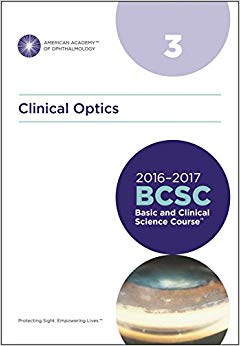
Upon completion of Section 3, readers should be able to:
*Outline the principles of light propagation and image formation and work through some of the fundamental equations that describe or measure such properties as refraction, reflection, magnification and vergence
*Define the various types of visual perception and function, including visual acuity, brightness sensitivity, color perception and contrast sensitivity
*Explain the optical principles underlying various modalities of refractive correction: spectacles, contact lenses, intraocular lenses and refractive surgery
Recently revised: 2013 2014
Section chair: Dimitri T. Azar, MD
Print: 366 pages
CME Information
The American Academy of Ophthalmology is accredited by the Accreditation Council for Continuing Medical Education to provide continuing medical education for physicians.
The American Academy of Ophthalmology designates this enduring material for a maximum of 10 AMA PRA Category 1 CreditsTM. Physicians should claim only the credit commensurate with the extent of their participation in the activity.
The American Medical Association requires that all learners participating in activities involving enduring materials complete a formal assessment before claiming CME credit. To assess your achievement in this activity and ensure that a specified level of knowledge has been reached, a posttest for this section of the Basic and Clinical Science Course is provided. A minimum score of 80% must be obtained to pass the test and claim CME credit. Visit CME Central for more information.
About the BCSC
The Academy’s Basic and Clinical Science CourseTM (BCSC®) is ophthalmology s definitive compilation of scientific research and clinical experience. It is continually updated by a faculty of more than 80 expert ophthalmologists. Each of the 13 volumes includes fundamental clinical knowledge; numerous tables, photos and illustrations; self-assessment questions with answers; and opportunities for earning AMA PRA Category 1 CreditTM.
Beginning with the 2013 2014 edition, the Academy and the European Board of Ophthalmology (EBO) have partnered to make the BCSC the standard text for all European ophthalmology training programs. The EBO now recommends the BCSC as the primary educational resource for European trainees and ophthalmologists studying for the annual EBO Diploma Exam.

